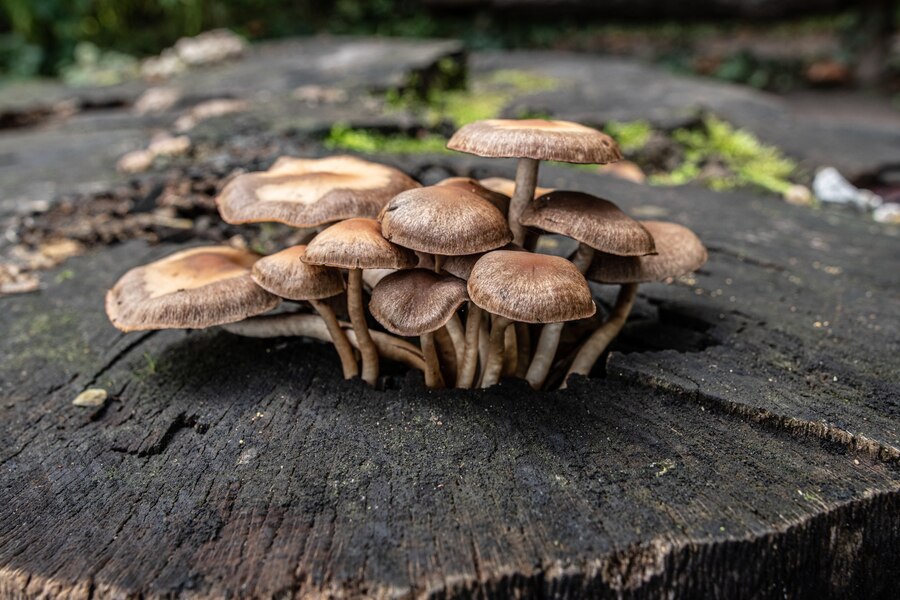In the enchanting realm of the natural world, the line that separates organisms can often blur, leaving us in awe of the fascinating diversity of life on Earth. In the intricate web of life, mushrooms and fungi stand as two enigmatic groups, each brimming with intrigue and vital ecological roles. But what distinguishes mushrooms from fungi, and how do they contribute to the planet’s vibrant ecosystems? Join us as we embark on a captivating journey to unravel the differences and similarities between mushrooms and fungi, shedding light on their significance in the grand tapestry of life.
Mushrooms: The Alluring Fruits of Fungi
Mushrooms, with their wide array of shapes, sizes, and colors, often steal the spotlight in the fungal world. These captivating organisms are the fruiting bodies of certain fungi, emerging from the ground or decaying wood in forests, fields, and even our own backyards. With their seductive allure and the promise of culinary delights, mushrooms are the charismatic ambassadors of the fungal kingdom.
Mushrooms in the Spotlight
Mushrooms have long held a prominent place in human history and culture. They have been featured in folklore, art, and cuisine, revered for their intricate beauty and culinary versatility. From the iconic fly agaric (Amanita muscaria) that stars in fairy tales to the beloved edible champignon (Agaricus bisporus) found in countless recipes, mushrooms have an undeniable allure. Their remarkable forms, ranging from delicate chanterelles to mysterious morels, make them an endless source of fascination.
However, it’s important to remember that mushrooms are merely the visible tip of a much larger and cryptic fungal iceberg.
Fungi: The Hidden Architects of Ecosystems
Fungi, the less conspicuous members of the fungal duo, play a critical role in the natural world. They are the “unsung heroes” of the ecosystem, often concealed beneath the soil or lurking within the decaying matter. Fungi constitute a kingdom all their own, with vast diversity encompassing yeasts, molds, and microscopic threads known as mycelium.
The Hidden World of Fungi
While mushrooms grab our attention, the true heart and soul of fungi reside beneath our feet. Mycelium, the thread-like network of fungal filaments, is the life force of fungi, working diligently in the dark recesses of soil, decomposing organic matter and forming symbiotic relationships with plants. This mycelial network can span vast areas, forming the largest living organisms on the planet, such as the Armillaria ostoyae in the Malheur National Forest of Oregon, USA.
Mycorrhizal fungi, in particular, are instrumental in maintaining the health of many plant species. They form mutualistic relationships with plant roots, providing essential nutrients in exchange for sugars. This remarkable partnership supports the growth of countless trees and plants, shaping entire ecosystems.
The Relationship Between Mushrooms and Fungi
So, where do mushrooms fit into the grand fungal scheme? Mushrooms are the reproductive structures of certain fungi, emerging when environmental conditions are favorable for spore production. These structures serve a vital purpose in the fungal life cycle, spreading spores far and wide to continue the fungal lineage.
The Fungal Life Cycle
The life cycle of fungi is a mesmerizing process that encompasses both sexual and asexual reproduction. It starts with the release of spores from the mushroom’s gills or pores. These spores, like tiny seeds, disperse into the environment, where they may encounter the necessary conditions to germinate.
When spores find a suitable substrate, they develop into mycelium, which gradually grows and expands. This mycelium can persist for years, even decades, continually breaking down organic matter and recycling nutrients in the ecosystem.
Under the right conditions, mycelium undergoes sexual reproduction, forming mushroom fruiting bodies that house and release spores. These spores, once again, venture into the environment to complete the cycle.
Mushrooms and Fungi in Ecology
Both mushrooms and fungi play pivotal roles in ecological processes, contributing to the health and balance of ecosystems.
Mushrooms: Decomposers and Spore Disseminators
Mushrooms serve as nature’s recyclers, breaking down dead organic matter, releasing nutrients back into the environment, and helping to maintain the equilibrium of ecosystems. They are integral in the decomposition of leaves, fallen trees, and other organic debris, ensuring that nothing goes to waste in the natural world.
Simultaneously, mushrooms function as spore-dissemination vehicles. As they release spores into the air, these particles can travel vast distances, potentially colonizing new habitats and perpetuating the fungal lineage.
Fungi: Ecosystem Architects
Fungi, especially mycorrhizal fungi, act as architects of ecosystems. These underground wonders form symbiotic relationships with plants, providing them with nutrients (particularly phosphorus and nitrogen) in exchange for carbohydrates produced through photosynthesis. This mutually beneficial partnership not only benefits the fungi and plants involved but also has far-reaching consequences for entire ecosystems.
Forests, for instance, depend on mycorrhizal fungi to facilitate nutrient uptake for trees. This cooperation between fungi and trees is a cornerstone of forest health, contributing to carbon sequestration and nutrient cycling. Without these symbiotic relationships, the world’s forests would be vastly different and less productive.
The Culinary and Medicinal Significance of Mushrooms
While fungi in the form of mycelium or molds have diverse applications, it’s the fruiting bodies – the mushrooms – that have the spotlight in the culinary and medicinal realms.
Culinary Delights
Mushrooms have earned their place on gourmet menus around the world. From the earthy richness of porcini mushrooms to the umami explosion of shiitakes, these fungi bring a unique and delightful spectrum of flavors and textures to the table.
Mushrooms are also praised for their nutritional value, being low in calories and rich in essential vitamins, minerals, and antioxidants. Additionally, they offer a unique source of dietary fiber and are often included in vegetarian and vegan diets as meat substitutes.
Medicinal Marvels
Beyond the kitchen, certain mushrooms have earned a reputation as potent medicinal agents. Traditional medicine systems, particularly in Asian cultures, have used mushrooms like Reishi (Ganoderma lucidum) and Lion’s Mane (Hericium erinaceus) for their potential health benefits.
Modern research has unveiled the therapeutic potential of these mushrooms, revealing their roles in supporting immune function, reducing inflammation, and aiding in various health conditions. These discoveries continue to fuel the interest in the study of fungal compounds for medical applications.
Closing Thoughts: The Fungal Symphony
Mushrooms and fungi, the captivating fruits and hidden architects of the fungal realm, contribute in myriad ways to the wonder and balance of the natural world. While mushrooms may dazzle us with their diverse forms and culinary allure, it is the silent, interconnected world of fungi that orchestrates ecosystems, nourishes plants, and recycles life’s essential nutrients. As we explore these enigmatic organisms further, we begin to grasp the intricate, harmonious symphony that fungi play in Earth’s grand narrative. Whether it’s the thrill of foraging for wild mushrooms or the awe of a forest’s mycorrhizal network, mushrooms and fungi continue to captivate





